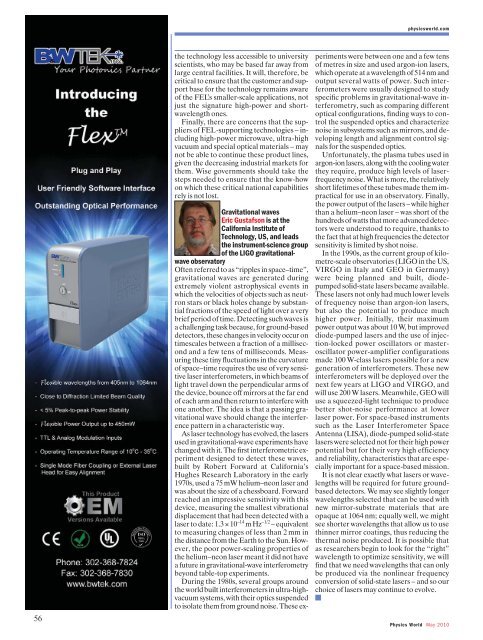special issue
special issue
special issue
You also want an ePaper? Increase the reach of your titles
YUMPU automatically turns print PDFs into web optimized ePapers that Google loves.
physicsworld.com56the technology less accessible to universityscientists, who may be based far away fromlarge central facilities. It will, therefore, becritical to ensure that the customer and supportbase for the technology remains awareof the FEL’s smaller-scale applications, notjust the signature high-power and shortwavelengthones.Finally, there are concerns that the suppliersof FEL-supporting technologies – in -cluding high-power microwave, ultra-highvacuum and <strong>special</strong> optical materials – maynot be able to continue these product lines,given the decreasing industrial markets forthem. Wise governments should take thesteps needed to ensure that the know-howon which these critical national capabilitiesrely is not lost.Gravitational wavesEric Gustafson is at theCalifornia Institute ofTechnology, US, and leadsthe instrument- science groupof the LIGO gravitationalwaveobservatoryOften referred to as “ripples in space–time”,gravitational waves are generated duringextremely violent astrophysical events inwhich the velocities of objects such as neut -ron stars or black holes change by substantialfractions of the speed of light over a verybrief period of time. Detecting such waves isa challenging task because, for ground-baseddetectors, these changes in velocity occur ontimescales between a fraction of a millisecondand a few tens of milliseconds. Meas -uring these tiny fluctuations in the curvatureof space–time requires the use of very sensitivelaser interferometers, in which beams oflight travel down the perpendicular arms ofthe device, bounce off mirrors at the far endof each arm and then return to interfere withone another. The idea is that a passing gra -vitational wave should change the interferencepattern in a characteristic way.As laser technology has evolved, the lasersused in gravitational-wave experiments havechanged with it. The first interferometric ex -periment designed to detect these waves,built by Robert Forward at California’sHughes Research Laboratory in the early1970s, used a 75 mW helium–neon laser andwas about the size of a chessboard. Forwardreached an impressive sensitivity with thisdevice, measuring the smallest vibrationaldisplacement that had been detected with alaser to date: 1.3 × 10 –14 m Hz –1/2 – equivalentto measuring changes of less than 2 mm inthe distance from the Earth to the Sun. How -ever, the poor power-scaling properties ofthe helium–neon laser meant it did not havea future in gravitational-wave interferom etrybeyond table-top experiments.During the 1980s, several groups aroundthe world built interferometers in ultra-highvacuumsystems, with their optics suspendedto isolate them from ground noise. These ex -periments were between one and a few tensof metres in size and used argon-ion lasers,which operate at a wavelength of 514 nm andoutput several watts of power. Such interferometerswere usually designed to studyspecific problems in gravitational-wave in -terferometry, such as comparing differentoptical configurations, finding ways to controlthe suspended optics and characterizenoise in subsystems such as mirrors, and de -veloping length and alignment control signalsfor the suspended optics.Unfortunately, the plasma tubes used inargon-ion lasers, along with the cooling waterthey require, produce high levels of laserfrequencynoise. What is more, the relativelyshort lifetimes of these tubes made them im -practical for use in an observatory. Finally,the power output of the lasers – while higherthan a helium–neon laser – was short of thehundreds of watts that more advanced detectorswere understood to require, thanks tothe fact that at high frequencies the detectorsensitivity is limited by shot noise.In the 1990s, as the current group of kilometre-scaleobservatories (LIGO in the US,VIRGO in Italy and GEO in Germany)were being planned and built, diodepumpedsolid-state lasers became available.These lasers not only had much lower levelsof frequency noise than argon-ion lasers,but also the potential to produce muchhigher power. Initially, their maximumpower output was about 10 W, but improveddiode-pumped lasers and the use of injection-lockedpower oscillators or masteroscillatorpower-amplifier configurationsmade 100 W-class lasers possible for a newgeneration of interferometers. These newinterferometers will be deployed over thenext few years at LIGO and VIRGO, andwill use 200 W lasers. Mean while, GEO willuse a squeezed-light technique to producebet ter shot-noise performance at lowerlaser power. For space-based instrumentssuch as the Laser Interferometer SpaceAntenna (LISA), diode-pumped solid-statelasers were selected not for their high powerpotential but for their very high efficiencyand reliability, characteristics that are e<strong>special</strong>lyimportant for a space-based mission.It is not clear exactly what lasers or wavelengthswill be required for future groundbaseddetectors. We may see slightly longerwavelengths selected that can be used withnew mirror-substrate materials that areopaque at 1064 nm; equally well, we mightsee shorter wavelengths that allow us to usethinner mirror coatings, thus reducing thethermal noise produced. It is possible thatas researchers begin to look for the “right”wavelength to optimize sensitivity, we willfind that we need wavelengths that can onlybe produced via the nonlinear frequencyconversion of solid-state lasers – and so ourchoice of lasers may continue to evolve.■Physics World May 2010



